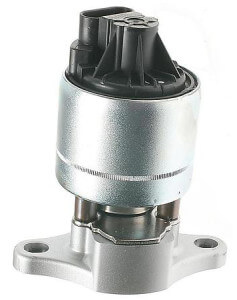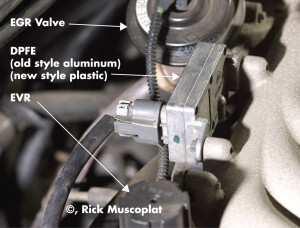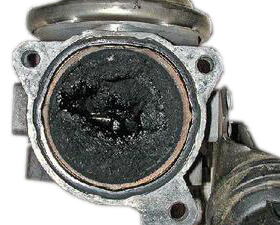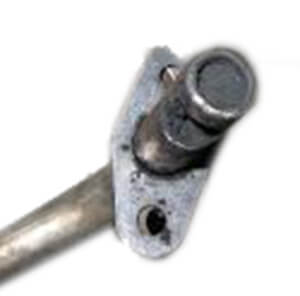What is an EGR valve?
What does an EGR valve do and can I delete my EGR?
I often see car owners ask how to perform an EGR delete. Doing an EGR delete is a really bad idea. But in order to understand why, I first have to cover, “What is an EGR valve.”
What does an EGR valve do?
When the EPA first addressed air pollution, they directed their attention to the amount of unburned hydrocarbons (HC), carbon monoxide (CO), carbon dioxide (CO2), and oxides of nitrogen (NOx). By adjusting and monitoring air/fuel mixtures, a modern computer and oxygen sensors can keep HC, CO, and CO2 under control. But reducing NOx is a bit harder. Nitrogen dioxide is just one of a group of reactive gasses referred to as “oxides of nitrogen,” or “nitrogen oxides (NOx).” These gases contribute to the formation of ground level ozone and small particle pollution. Plus, NO2 directly contributes to respiratory problems.
An EGR valve reduces oxides of nitrogen emissions by helping to cool the combustion event to prevent the formation of oxides of nitrogen. NOx forms when Nitrogen in the air combines with oxygen at high combustion temperatures. So the only way to reduce NOx is to reduce combustion temperatures.
Car maker accomplish that by recirculating a small amount of exhaust gas back into the cylinder during the intake stroke. Exhaust gas doesn’t burn, so you’re basically adding a non-burnable ballast to the mixture. In most cases, the EGR valve only adds up to 15% to the total air/fuel charge. But that 15% of non-burnable exhaust lowers combustion temperatures enough to reduce NOx significantly. Now this is important: The goal is to reduce NOx, but to do that, car makers need to reduce combustion temperatures. Exhaust gas recirculation has no other purpose but to reduce combustion temperatures.
When an EGR system fails, many people think they can just perform an EGR delete without having any affect on their engine. “It’s just an air pollution device,” they say. But when you perform an EGR delete on an engine that’s designed to use EGR, you can cause serious damage to the engine. So it’s not simply an air pollution issue.
How do an EGR valve reduce emissions?
An exhaust gas recirculation (EGR) valve does exactly what the name implies—it recirculates exhaust gas to reduce emissions. What the car makers are most concerned about is Oxides of Nitrogen (NOx), a major component of smog. NOx forms when combustion temperatures are high. That normally occurs at the peak of compression/combustion. The nitrogen in the air combines with oxygen in the air/fuel mixture to form NOx.
So automakers reintroduce exhaust gas under certain conditions to cool the combustion process. Cool is kind of a misnomer. The exhaust gas doesn’t actually cool. It acts as ballast to reduce the amount of air/fuel needed to maintain power.
If exhaust gas is introduced when the car is at idle or low RPMs, the engine would choke and die. So the computer commands full closure of the valve during those periods. But at higher RPMS when the vehicle is cruising, each intake stroke pulls in a set amount of cc’s of air/fuel whether it needs it or not. During those conditions, the computer commands varying amounts of EGR to save gas, reduce combustion temperatures, and stay within emissions standards.
What happens when you do an EGR delete?
When car owners perform an EGR delete they usually just add a metal plate between the EGR valve and the manifold. That stops the flow of exhaust gas recirculation. But it also eliminates the cooling effect of exhaust gas recirculation. NOx goes up and so does combustion temperature. On engines designed to run with EGR flow, the increased combustion temperatures create pre-ignition (ping/knock) that can eventually damage piston. And, the higher than expected temperatures burn exhaust valves and can even burn holes in the piston heads. So you’re literally burning up your engine when you do an EGR delete.
A little more on how EGR valves work
So far I’ve explained that car makers use exhaust gas recirculation

Electrically controlled EGR valve with position sensor on the top
to cool down combustion temperatures. But you can’t add exhaust gas to an idling engine—that non-burnable gas will cause a rough idle or even stall the engine. In fact, a rough idle is one of EGR symptoms. To prevent rough idling, the PCM tries to match EGR flow to engine RPM and acceleration demand. The older EGR valves regulated EGR flow with engine vacuum attached to vacuum actuators that lifted the EGR pintle off its seat. Later generations used a pulsing solenoid to regulate how much vacuum flowed to the vacuum actuators on the EGR valve. The latest EGR valves are opened and closed electrically, using varying amounts of electrical current in a solenoid. In addition, the EGR valve includes an EGR valve position sensor to provide feedback to the PCM. The PCM compares commanded opening instructions to the actual opening to determine if the EGR valve is performing properly.
If the commanded opening doesn’t match the actual opening, the PCM will set a P0404 Exhaust Gas Recirculation Circuit Range/Performance trouble code. This code is usually caused by a faulty position sensor. Replacing the EGR valve usually fixes the problem.
The PCM knows how much EGR is commanded and it knows how far the valve actually opened. But it must also know if the commanded open resulted in the expected flow. Keep in mind we’re recirculation exhaust gas that contains soot, oil, and unburned hydrocarbons. So there’s plenty of opportunity for that dirty gas to build up and clog the passages.
There are several ways to detect clogged passages. Ford has used a
Differential Pressure Feedback sensor. Ford placed a restriction in the EGR tube from the EGR valve to the intake. They then attached a tube on each side of the restriction and the sensor measured exhaust pressure on both sides. Great idea in theory, not so great in practice. The exhaust gas corroded the DPFE sensor.
Another way to detect exhaust gas flow restriction is to command EGR flow at a low RPM. The PCM expects the engine to stumble. If it does, it knows the EGR is flowing properly. If it doesn’t, it’ll set one of these codes:
P0400 Exhaust Gas Recirculation Flow Malfunction
P0401 Exhaust Gas Recirculation Flow Insufficient Detected
P0402 Exhaust Gas Recirculation Flow Excessive Detected
The PCM also monitors electrically operated EGR valves.
If there’s an issue with these EGR valves, you get one of these codes:
P0403 Exhaust Gas Recirculation Circuit Malfunction
P0405 Exhaust Gas Recirculation Sensor A Circuit Low
P0406 Exhaust Gas Recirculation Sensor A Circuit High
P0407 Exhaust Gas Recirculation Sensor B Circuit Low
P0408 Exhaust Gas Recirculation Sensor B Circuit High
EGR valve replacement cost
EGR valves are fairly inexpensive, ranging from as little as $40 for an aftermarket unit, to around $180 for factory units. But total EGR valve replacement cost with labor can run around $200 to as high as $400 if the valve is located in a difficult location. That’s why car owners are tempted to perform and EGR delete. What they don’t consider is how much damage the EGR delete will do to their engine.
EGR cleaning
Since we’re dealing with dirty exhaust gas, it’s not uncommon for the valve to accumulate carbon buildup on the port and pintle. Sometimes you can perform an EGR cleaning operation by removing the valve and scrubbing it with a steel brush and throttle body cleaner. EGR cleaning only works about 50% of the time. That’s because the buildup is very hard to remove.
EGR passage blocked
Exhaust gas passages run from the exhaust manifold to the EGR valve, and from there to the throttle body or intake manifold. Over time, those passages can clog with carbon. In those cases, the shop may have to remove the throttle body or intake manifold and clean out the passages. It’s done with drills and flexible scrubbing cables (kind of like using a pipe cleaner to clean small passages. In the worst cases, the intake manifold must be replaced.
In summary
EGR valves perform an important function in keeping our air clean by reducing combustion temperatures. If you do an EGR delete, you eliminate the cooling effect of EGR. The higher combustion temperatures will cause detonation, piston damage, and burn your exhaust valves. In other words, an EGR delete will also damage your engine.
©, 2015 Rick Muscoplat
Posted on by Rick Muscoplat



